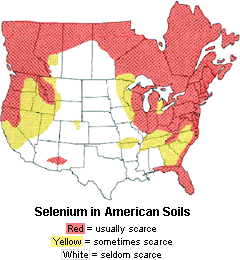Selenium
|
This sulfur-like (pronounced suh-LEE-nee-um) is an that apparently helps to prevent cancer and hypertension.
(In areas of the United States and Canada where selenium is scarce in
the soil, cancer and stroke rates are higher.) Selenium also helps to
regulate the action of thyroid hormones.
Good sources of selenium include whole-grain
cereals, organ meats, chicken, egg yolks, seafood, milk, and garlic. (Selenium
is often added to antioxidant vitamin supplements, too.) In places where
the soil is rich in selenium, many plants contain higher than average
amounts of the mineral.
Selenium overdose can trigger a toxic reaction,
selenosis, marked by hair loss and fingernail and toenail damage. |

|
Your Daily Allowance
Diet Power sets your
of selenium at the , which is specified in . The RDA for people 14 and older is 55 micrograms. For
pregnant women it is 60 micrograms; for lactating mothers, 70 micrograms.
Upper Limit
In April 2000 the FNB
established the first for selenium. For everyone 14 or older it's 400 micrograms
per day. Getting more than the UL may harm your health.
Revising Your Allowance
Diet Power automatically
sets your Personal Daily Allowance of selenium when you enroll in the
program, but if your doctor recommends a different allowance, you can
change it. See Personal Daily Allowances, Editing Your.
Color Coding of This Nutrient
The selenium bar in your personal Nutrient
History is:
 blue for "good" if you've logged 100 to 150
percent of your PDA
blue for "good" if you've logged 100 to 150
percent of your PDA
 red for "bad" if you've logged less than 100
percent of your PDA or more than the Tolerable Upper Intake Level (UL)
red for "bad" if you've logged less than 100
percent of your PDA or more than the Tolerable Upper Intake Level (UL)
 yellow for "caution" if you've logged more
than 150 percent of your PDA
yellow for "caution" if you've logged more
than 150 percent of your PDA
 missing if you've logged no selenium
missing if you've logged no selenium
In the of a food or recipe, the selenium bar is:
 green for "good" if getting your entire PDA
of calories from this item would give you more than 150 percent of your
PDA of selenium
green for "good" if getting your entire PDA
of calories from this item would give you more than 150 percent of your
PDA of selenium
 magenta for "bad" if getting all your calories
from the item would give you less than 50 percent of your PDA of selenium
magenta for "bad" if getting all your calories
from the item would give you less than 50 percent of your PDA of selenium
 blue for "neutral" otherwise
blue for "neutral" otherwise
 missing if the amount of selenium is either zero or
(when the word Selenium is ) unknown
missing if the amount of selenium is either zero or
(when the word Selenium is ) unknown
How Complete Are Diet Power's Selenium Readings?
For
the 8500 generic items in the Food Dictionary: not terribly complete.
About 30 percent list their selenium content as "unknown."
For
the 2500 chain-restaurant items: totally incomplete.
All list selenium as "unknown."
For
all 11,000 items combined: not terribly complete. About 46 percent
list selenium as "unknown."
These figures mean that your Nutrient History
will almost always underreport your intake of selenium, unless you log
mostly foods with selenium readings that you've added to the dictionary
yourself.
To see whether a particular
food has a selenium reading, open the Food Dictionary and check the food's
nutrient profile. If you find a question mark beside "Selenium,"
it means the amount is unknown. (To see all
foods with unknown selenium readings, click the dictionary's PowerFoods tab and sort the foods by selenium power; then scroll
toward the bottom of the list until you see foods with question marks
in the "Power Rating" column.)
Selenium on Food Labels
Food labels are not required
to report selenium content, but some do voluntarily. They may cite the
content in micrograms, percent of , or both.
The Daily Value for selenium is 70 micrograms.
This isn't necessarily right for you, however¾it's
a rough estimate meant to cover most of the U.S. population. (Remember,
too, that the Daily Value does not yet reflect the new RDA announced in
April 2000. See above.)
For more on label regulations,
see Labels,
Food.
Got
a Suggestion for This Page?
Last Modified: 7/27/07

 blue for "good" if you've logged 100 to 150
percent of your PDA
blue for "good" if you've logged 100 to 150
percent of your PDA red for "bad" if you've logged less than 100
percent of your PDA or more than the
red for "bad" if you've logged less than 100
percent of your PDA or more than the  yellow for "caution" if you've logged more
than 150 percent of your PDA
yellow for "caution" if you've logged more
than 150 percent of your PDA missing if you've logged no selenium
missing if you've logged no selenium green for "good" if getting your entire PDA
of calories from this item would give you more than 150 percent of your
PDA of selenium
green for "good" if getting your entire PDA
of calories from this item would give you more than 150 percent of your
PDA of selenium magenta for "bad" if getting all your calories
from the item would give you less than 50 percent of your PDA of selenium
magenta for "bad" if getting all your calories
from the item would give you less than 50 percent of your PDA of selenium